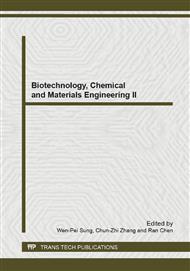[1]
Lu YP, Chen YG, Wen J (2004). A new bioflavone Selaginella doederleinii. Yunnan Zhiwu Yanjiu., 26(2): 226-228.
Google Scholar
[2]
Lin RC, Skaltsounis A L, Seguin E, Tillequin F, Koch M (1994). Phenolic constituents of Selaginella doederleinii. Planta. Med., 60(2): 168-170.
DOI: 10.1055/s-2006-959443
Google Scholar
[3]
Lin RC, Elisabeth S, Francois T, Michel K (1987). New alkaloid glycosides from Selaginella doederleinii. J. Nat. Prod., 50(3): 422-426.
DOI: 10.1021/np50051a013
Google Scholar
[4]
LUCCHESI M E, CHEMAT F, SMADJA J. Solvent-free microwave extraction of essential oil fromaromatic herbs: comparison with conventional hydro-distillation[J]. Journal of Chromatography A, 2004, 1043 (2): 323-327.
DOI: 10.1016/j.chroma.2004.05.083
Google Scholar
[5]
GAO Shan, HAN Wei, DENG Xiu. Study of the mechanism of microwave-assisted extraction of Mahoniabealei (Fort. ) leaves and Chrysanthemum morifolium (Ramat. ) petals[J]. Flavour and Fragrance Journal, 2005, 19(3): 244-250.
DOI: 10.1002/ffj.1296
Google Scholar
[6]
YOUN Y S, MING Y K, YUAN S C. Microwave-assisted extraction of ginsenosides from ginseng root[J]. Microchemical Journal, 2003, 74(2): 131-139.
DOI: 10.1016/s0026-265x(02)00180-7
Google Scholar
[7]
GONG SZ, CHENG J, YANG ZR. Microwave-assisted extraction of isoflavones from Belamcanda chinensis[J]. Chinese Journal of Chemical Engineering, 2005, 13(4): 556-559.
Google Scholar
[8]
XIAO Weihua, HAN Lujia, SHI Bo. Microwave-assisted extraction of flavonoids from Radix Astragali[J]. Separation and Purification Technology, 2008, 62(3): 614-618.
DOI: 10.1016/j.seppur.2008.03.025
Google Scholar
[9]
GIRIJA R, VILAS G G. Microwave-assisted extraction of piperine from Piper nigrum[J]. Industrial & Engineering Chemistry Research, 2002, 41(10): 2521-2528.
DOI: 10.1021/ie010359b
Google Scholar
[10]
PAN Xuejun, LIU Huizhou, JIA Guanghe, et al. Microwave-assisted extraction of glycyrrhizic acid from licorice root[J]. Biochemical Engineering Journal, 2000, 5(3): 173-177.
DOI: 10.1016/s1369-703x(00)00057-7
Google Scholar
[11]
PAN Xuejun, NIU Guoguang, LIU Huizhou, et al. Comparison of microwave-assisted extraction and conventional extraction techniques for the extraction of tanshinones from Salvia miltiorrhiza Bunge[J]. Biochemical Engineering Journal, 2002, 12(1): 71-77.
DOI: 10.1016/s1369-703x(02)00039-6
Google Scholar
[12]
INCORVIA M M J, IANNUCCI B W A, DENSON C L. Microwaveassisted extraction of taxanes fromTaxus biomass[J]. Journal of Agricultural and Food Chemistry, 1997, 45(12): 4691-4696.
Google Scholar


